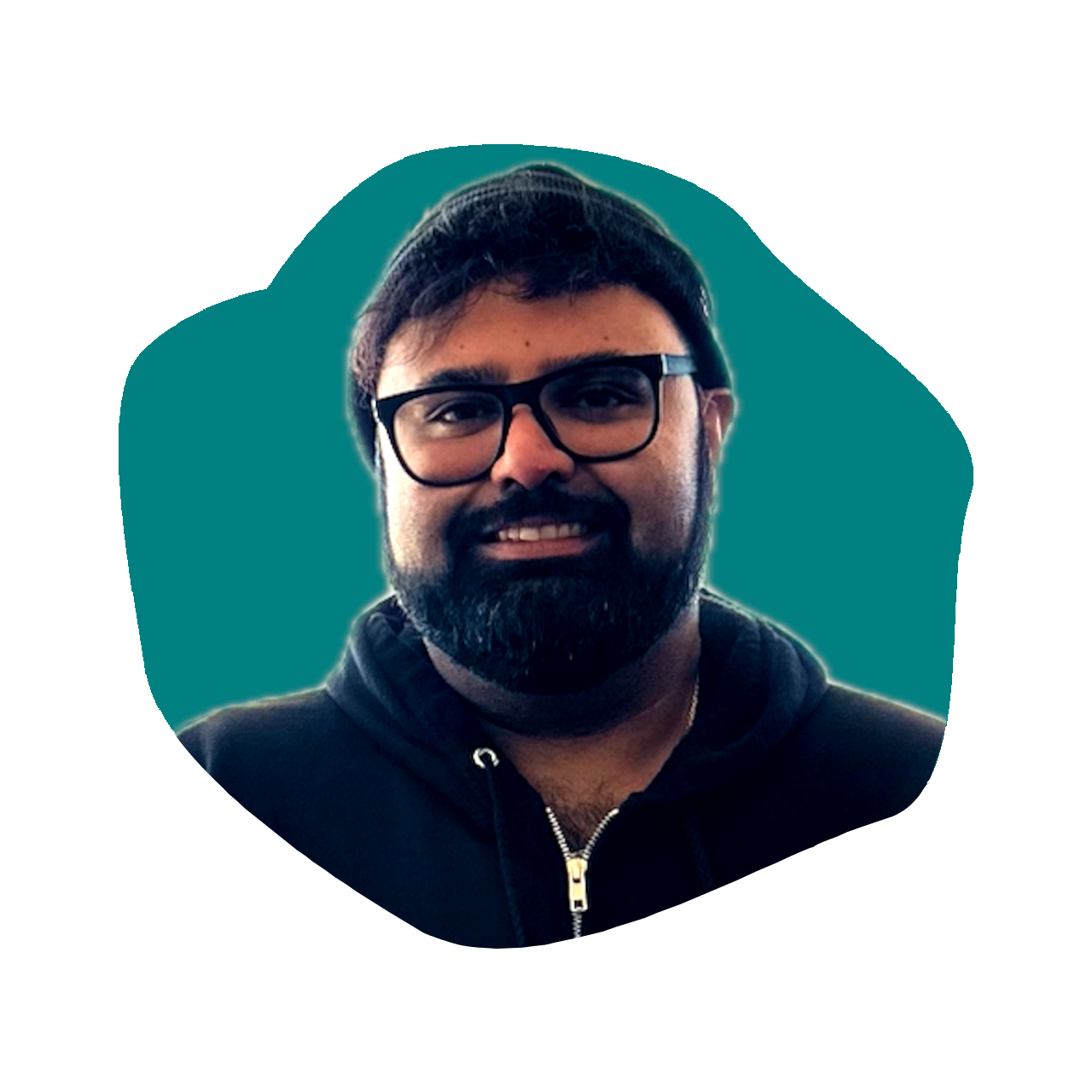Chirag Nangia: Co-Founder of GUSSA
Episode 688

On this episode of The Kara Goldin Show, we’re joined by Chirag Nangia, Founding Team Member of GUSSA—the bold new sauce brand bringing a sweet and spicy kick to kitchens everywhere. Crafted proudly in India with a special blend of local spices, GUSSA is reimagining what a condiment can be, delivering a unique flavor profile that’s anything but ordinary.
In our conversation, Chirag shares the inspiration behind launching GUSSA, the story behind the brand’s unforgettable name, and how he made the leap from software entrepreneur to food founder. We dive into the art of crafting a sauce that balances sweetness and heat, what it takes to cut through the noise in the crowded food space, and why staying authentic to the brand’s roots has been key to its early success. Chirag also gives us a glimpse into the lessons he’s carrying from tech into the world of food and what’s next as GUSSA looks to scale.
Whether you're a food lover, an aspiring founder, or someone who loves bold moves and even bolder flavors, this episode is packed with energy and insights you won’t want to miss. Now on The Kara Goldin Show.
Resources from
this episode:
Enjoying this episode of #TheKaraGoldinShow? Let Kara know by clicking on the links below and sending her a quick shout-out on social!
Follow Kara on LinkedIn – Instagram – X – Facebook – TikTok – YouTube – Threads
Have a question for Kara about one of our episodes? Reach out to Kara directly at [email protected]
To learn more about Chirag Nangia and GUSSA:
https://www.instagram.com/getgussa
https://www.linkedin.com/in/chinangia/
https://www.gussa.com/
Transcript
Kara Goldin 0:00
I am unwilling to give up that I will start over from scratch as many times as it takes to get where I want to be. I want to be you. Just want to make sure you will get knocked down. But just make sure you don’t get knocked out, knocked out. So your only choice should be go focus on what you can control. Control. Hi everyone, and welcome to the Kara Goldin show. Join me each week for inspiring conversations with some of the world’s greatest leaders. We’ll talk with founders, entrepreneurs, CEOs and really, some of the most interesting people of our time. Can’t wait to get started. Let’s go. Let’s go. Hey, everyone, welcome back to the Kara Goldin show. Super excited to have my next guest here, Chirag Nangia. He is the co founder of an incredible, fairly new brand called GUSSA. If you have not heard of goosa yet, you need to order it. Get run into your local store, you are going to be so, so excited about this sauce. So anyone who knows my husband, Theo, is super into hot sauces. And when he tried GUSSA, he immediately grabbed it. Thought it was ketchup at first, and then said, Wait a minute, what is this? And he tried it, and he was, like, so excited. He had to call Chirag and tell him that it was it, this is so, so great. So anyway, today we’re going to dive into the brand, the journey that it’s taken to get there as well. And more than anything, talk about what it’s been like to grow a brand in an industry that Chirag has never been in, and he and his co founders decided to jump in and just make this happen. So before GUSSA, Chirag was deep in the world of tech and software startups. Now he’s combining his entrepreneurial spirit with culinary passion to launch a brand that really is redefining what we expect from, I guess, a ketchup but putting Indian flavors front and center. So I cannot wait to get into this interview, Chirag, welcome so excited to have you here.
Chirag Nangia 2:25
What a pleasure to be on. I’m so I’m so happy to be doing this, and it’s my birthday today, so I’m especially happy to be doing this on my birthday. Well,
Kara Goldin 2:32
happy birthday, and I’m so honored that you chose to come on the show. What better to be? Where better to be? Exactly, exactly. So, okay, so can you describe what is goosa? And how do you describe it to somebody who has has not heard of Gusa before?
Chirag Nangia 2:52
So what people have told us? It’s a great question, what people have told us, and so, almost, like when they first tried, we’ve done a lot of sampling events. It’s, the immediate, almost, I would say, like, if you were to do like a heat cloud of the what people have responded, but it’s almost always like Indian Sriracha is what we’ve heard probably most often. And we haven’t really used those words ourselves in our marketing or whatever. But I feel like that’s where people have kind of almost pushed it into it’s almost like it’s the Indian Sriracha. And some people come back and say, Oh, actually, no, it’s better than this route to the next Sriracha, or something of that nature. I’ll give you kind of the story behind it for most Indians and South Asians, I think broadly, you know, the condiment we almost keep in like, everyone probably has something in their fridge, something similar to this as kind of a sweet and spicy sauce with some of some Indian flavors to it. And people go through, like, you know, a large bottle, a kilogram bottle, like, a week, right? Like people will use it in the morning with eggs, cereal, I mean, you name it. Like, people will douse everything with the sauce. And it’s almost a way to make anything that’s kind of bland, kind of full of flavor, flavor. So we kind of all grew up with this type of product. And there’s a few players who’ve been, you know, dominating this market for a while. And most ingredients in, you know, those sauces, a little bit suspect. So that’s kind of where this started for for me, where, you know, looking at that kind of set where most of us kind of grew up with, you know, back back in India, and also, kind of around the world. I grew up all over. I grew up in New Zealand, UK, India, you know, all over the place, us, obviously, now for lost 30 years or whatever. But it’s, it’s the kind of common thing everyone has one of these things in their home. And you know, for us, we want to take look at that and say, Hey, can we do better version of this? Right? Can we do a, you know, clean label, non GMO version of this. But not only, you know, that takes the same flavor profile, but kind of introduces a more unique, more well rounded, almost a more adult version of that flavor profile, not so sugary, not so sweet, you get a little bit more characteristic to the flavor, and so on. So that’s kind of what go say is, in a sense. So yeah, people say Indian Sriracha. I would say. A little bit more complex than that. This is an Indian Sriracha. It’s kind of all purpose condiment you can use from anything from pizza to hot dogs to pasta to you name it. But kind of like what Sriracha became, right? In a sense, where people started to use Sriracha with tacos to barbecue to you name it. And we kind of think there’s an opportunity there for, you know, something like that, coming with a little bit of the Indian taste profile to the world. I
Kara Goldin 5:25
love how you first described it to me when I met you, guy, Kawasaki is a mutual friend, and had introduced me to you and to the brand. But I loved it when we first met and you talked to me about how goosa is used, not just on, you know, meat, but also or vegetables or as a marinade, but also on ice cream. And I was like, wait, what this is? This is wild. It’s used on everything.
Chirag Nangia 5:54
Top Tip, Bloody Mary, you know, I, you know, I wouldn’t, you know we’re recording with 2pm It’s probably birthday, I probably have a Bloody Mary now, but it’s a great, bloody merry mix. I’ve got a friend of mine who’s doing pizzas as a base with the with the gussau sauce, because a chain of Mexican restaurants here in Boston called boloco, and they’re using, they actually replace their tabletop, like Tapatio, and they’re kind of the set with Gusa, and their customers are loving it. They’re like, what is this? It’s so crazy, but it’s so good. It totally works with that the usage kind of patterns, I mean, we’re learning, actually, when we first brought our, I would say, first shipment in about eight, nine months ago, to the US, first US shipment, we tested it out a bunch of communities. And actually one of the other communities like barbecue, you know, because it has a sweet, it has a spice, it has a little bit of smokiness. So as a barbecue rub or barbecue sauce, works great. See, there’s the, I mean, my mouth is watering, talking about all of these things, is, I haven’t actually had, you know, anything to eat yet, but, you know, it is. It is a type of condiment which can work with a lot of stuff, and has a kind of a kind of a pretty unique taste profile. But it’s not like so overpowering or so spicy where it’s going to kind of take over the flavor of what you’re eating. It’s hopefully it will enhance whatever you’re having as a base flavor. And you know, I think that’s the type of stuff that I get passionate about, because I love eating. I love cooking and eating and all this good stuff. So
Kara Goldin 7:12
no, I love it. I think that the other thing that’s really interesting and so timely is that, especially in the Indian culture, from what I’ve heard, it’s all about multi generational families and all living together, in many cases, and cooking together. I think that something like Gusa would probably bring back a lot of memories, not just for you, but also for consumers, and especially if it’s more in tune with the lifestyle that maybe they’re leading today, shopping at Whole Foods or air one or, you know, the farmers market now, they can actually have a product that not only creates great food, but also brings back memories. I’m curious if this was something that you or your grandmother, or somebody used in your house as well.
Chirag Nangia 8:04
Well, I’ll tell you what I remember starting the name gusta came from. It was like during pandemic, I think, is where we’re, just idea first started, right? So we’re all in the kitchen. I think I was locked in California for about four or five months at the time I lived in London, but I would just happen to be home. And then literally, every every flight got canceled, right? And you had to stay where you were. And so I just, you know, went down to my parents house, and I was in the kitchen. And, you know, we’re not really used to living together the same house after this time. And I think it was making something of a mom stop in, and she’s, you know, I said something back. I think in my mind was something else. It’s like trying, which basically means angry. And I think when the name clicked, right? I was like, I was like, oh, maybe there’s something here, and it’s kind of where, I mean, you know, and I think I was actually using one of these kind of non, you know, these comparable sets or whatever. And I was like, oh, maybe there’s something interesting to be done. Definitely. That’s part of what we were kind of going for. When we were kind of thinking about how we create this brand. Was both to kind of go after this, you know, now this Indian demographic that’s kind of all around the world, right? You know, if you think about, you know, you know, from anywhere from, especially, you know, some of the former, you know, Commonwealth countries, you know, they’re very strong and in the US and so on. And, you know, kind of all the culinary tradition that was always there is evolving as well, right? So, if you think about 20 years ago, the Indian restaurant set used to be, kind of these buffet restaurants that were, you know, a little bit dodgy at some points, right? Not necessarily, you know, the highest quality food or whatever. But you now look at Indian food getting Michelin star and and, you know, just completely revamping what Indian cuisine is and what Indian flavors can be, and also the acceptance of Indian flavors and kind of a wider demographic, right? If you think about how there’s local sandwich chain here, you know, they’re just doing your normal sandwiches, but they always have an Indian flavor sandwich on the menu, and it always is their top seller, right? Because it’s, it’s not the Indian diaspora who’s necessarily eating that. It’s actually the price. Diaspora, we brought a broader demographic. Was eating that, right? And I think that’s also kind of part of our passion, and taking this, what is, I think, these really compelling Indian flavors, you know, the home of spice, a home of all of this beautiful flavors that we were, I grew up with, and we all grew up with, and kind of introducing it to a larger set in a way that’s palatable and kind of works with a lot of different type of food. So you can make anything, you know, full of flavor, full of thing, and just other day or at Costco, and we got Costco hot dogs for $1.50 best deal in the world. I put a little goose on. We brought our own goose, right? We put our goose on. It was so good. It was the best version of that Costco hot dog, right? So, yeah, there’s so many things you can just pull off with it that makes everything so much more exciting. And that’s kind of, I think part of our ambition for the brand is that it’s, yeah, rich Indian heritage, rich in your you know, products made India look a lot of truth in kind of what we’re doing, but also how we can take it to the broader demographic, and take it to the broader thing, including our launch of Whole Foods, right? So, this month, Whole Foods launch, and, you know, Whole Foods kind of tell yeah, there’s Indians that go there, but go there. So part of our strategy is to kind of appeal to that larger, larger demographic, and have people hopefully get really passionate about the flavors and everything else
Kara Goldin 11:16
we’re doing. So you’re a serial entrepreneur, you’ve been in the software and tech world, and you decide to venture into this entirely new industry. I’m very similar, but more than a few years ago when I did it, but when you decided to make the jump into the food world, did you actually think it was going to be easier than it is.
Chirag Nangia 11:43
I thought it could be easier than it is. I just was not expecting Excel files to see so many Excel files. I’ll be honest with you, I thought the world had moved on from, you know, 20 tab Excel files of filling out product information, you know, in different fields and then doing the same, you know, information in a slightly differently structured Excel file for a different person, for use right out of the world. I moved on from there. I wasn’t expecting all of that. We joke around that a lot in the team. It’s just, you know, how I feel like there’s still a lot of you know, opportunity for tech innovation, distribution, probably, but I think part of you know, having built companies before in tech and having done it, I think it, you know, generally, you know, I think most of the time it comes down to team for and I think when we were starting off, it was this idea first starting and going back to pandemic, you know, I was that time at meta as an entrepreneur resident, building, you know, products around Metaverse and all this other stuff. And, you know, I was like, this is an area that, you know, if I were to ever pursue this, it’s an area that I there’s no way I could do this myself, right? You know, coming in and trying to start something that I have zero experience with. So I reached out to a friend of mine, Daniel Caballero, who’s been in the food business and has an amazing food brand called FiOS, f, i, l, l, o, s. Shout out to them. If you ever want a tamale, it’s kind of most amazing rate to eat tamale out of a pouch. So reach out to him. Was like, Hey, Dan, you know, what is, what do you think about doing a food brand together, bringing together is like the rich Indian flavors and kind of taking it to the world. So he got it. And I think that for me, you know, that was some validation. We did some, you know, market research, and we looked at, you know, opportunity and gaps in the market and so on that we could go after. And I think, without see, without having something of that, you know, in the team, there’s no way this time, I would have ever gone off the ground. And then, you know, similarly, we reached out to the other founder in India, who had built, been part of India’s probably most successful consumer brand in the last, you know, 2030, years beer, 91 beer brand, excellent, you know. Now I think, you know, off to some crazy global presence. So he joined us as a founder. And, you know, I think, you know, getting building that initial team, you know, gave us the ability to both tap into, yeah, my, some of my entrepreneurial spirit, who, you know, figures out hacks for everything. But also, you know, the kind of the experience of having built solid consumer brands and done so in multiple markets as well, in kind of, what our ambition was to take this India brand, India first brand, to the world, right? You know, take it to the US. Take it to Canada. Take it to the UK, this year, where we’re going to be launching, probably Australia as well, maybe this year next year, and use this kind of, you know, you know, hyper connected world as a way to kind of grow something in a different way that you know, you may have done 20 years ago or 30 years ago or 40 years ago. It’s a very different time to kind of think about this stuff, and using social media and everything else as a way to kind of, you know, basically put this on on rocket fuel. So, yeah, I’m super excited, you know? I think the team is what enabled all of that, though,
Kara Goldin 14:45
that’s awesome. So you and your co founders are getting space. You’re filling out those spreadsheets, those Excel spreadsheets, and getting the space to introduce consumers. You’re also getting. Into different food service opportunities and getting chefs to use the product as well. How else are you cutting through to getting goosa noticed?
Chirag Nangia 15:12
That’s a great question. I mean, think right now, what we’ve been trying to do is make sure wherever we kind of introduce it, we have, you know, the kind of the plan built around how to make successful, for example, for Whole Foods, you know, you’ve done the whole foods launch a few times. We talked about this on our first conversation, right? Like you’re really understanding how we can not just put it on a shelf, but actually, you know, convert that into sales through sampling and promos and promos and all these other stuff that you have to do to make it successful, right? But I think the other thing we want to kind of bring into that is like, recall, right? Because when you see on the shelf for the first time, you may be less likely to pick it up, but if you’ve seen it at your local sandwich shop or a little you know, taco shop or whatever, you may be more likely to, you know, pick it up, especially if you’ve tried it before. Because most likely, if you try it, you it will be more likely, hopefully, pick it up, but you like it, so kind of building out that kind of foundation of kind of of the brand throughout all the channels. You kind of gonna get exposed through it throughout the day. That’s what we’ve been really trying to focus on. I mean, part of that also is like digital, right? So I think this year, we’re also looking at Tiktok as a way to kind of really bring this brand to another audience, you know, not necessarily the same audience as Whole Foods, right? I think, you know, we spoke about this a little bit as well, you know, maybe demographically quite different to the whole foods audience. But, you know, there probably is some crossover. But even if there’s not, you know, having that kind of, you know, the basically, the brand be able to kind of speak to this demographic. I think we can, we can, we can, we can, we can kind of go cater to a bunch of this stuff. But the idea is, really, ultimately, you know, you see, there’s so many sauces, even in the set today at Whole Foods, there’s, you know, 4050, plus, you know, condiments that are all kind of competing for attention. I think what we’re doing is interesting. The bottle does stick out on the shelf. I had to have some props, so there’s my bottle. It does take out on shelf. But, you know, just to make sure we are, we have one facing right now, right it’s a single product. And, you know, I think we want to make sure when people see it, they’ve maybe seen it before, whether it’s like through sampling or whatever else we’re doing events, we’re doing a bunch of this other stuff throughout the, you know, New England area, and as we’re currently at Whole Foods, and, you know, again, taking that broader as we go through through this launch, I think that’s, that’s the key to success. And I think we talked, we spoke about a lot of this stuff before, but I think when people try it there, most people really like the product. You know, I’ve had people who’ve some of these sampling events, who’ve tried it, like, oh my god, it’s spicy. Oh my god, oh my god, too spicy. And they’re like, oh, you know, do you want some cracker? Like, yeah, and take a cracker and then took more sauce on it, and then eat it again, right? I’m like, You just said it so spicy. Just having more for the money, it’s so spicy, but it’s so addictive. So it’s like, okay, I’m glad you like it, right? So, yeah, I think we want to just double down on that, get people to try their product. The more people try it, I know more people are gonna love it. That’s, I think that’s kind of the thing, right? I think it’s one of those things where it kind of sells itself once you have once you have it. So
Kara Goldin 18:07
that’s good. Are there different I’m so curious with Gusa is, are there different flavor profiles? Is that something in the future that maybe you would look at or and again, I’m just curious. Like, of course, I think that you’ll probably do different sizes, maybe different types of containers in the future. But is there any, is there any plans for when you expand? Are there different types of flavor? Are they? Is there, like, a low end spice versus a high end spice? I have no idea you like, Look ketchup. Is ketchup, right? And it’s it, there’s no need, I think a lot of people would say, to go beyond that. You know, one skew, even though they have over over the years. But I’m curious, is that the same with Gusa? Or could you see it actually going into different segments?
Chirag Nangia 18:58
Yeah, it’s a really good question. I mean, I think we’ve also kind of thought about, thought through this quite a bit internally, and I think certainly from heat level, I think playing around with having multiple levels of heat maybe more because less cost, or something like that, I think would certainly be interesting. You know, we’ve had kind of both requests, right? We’ve had people ask us to bring it down a notch, and we invite people to bring it up a notch, right? I’m probably bring more up a notch category. So I think kind of catering for that, and we understand that’s not going to be the bulk of the sales, you know thing, the bulk of the interest will still be on the flagship, but kind of having a bit of plus minus skew, at least available on heat would be interesting. But I think what we are also kind of convinced is that we don’t necessarily want to go and try to create, like, a bunch of different flavors, you know, that bring in, you know, new, new flavor sets to the thing. I think we kind of view this as more, you know, the saracha model, in a sense, right, where we see this as, like a flavor profile that can be applied to a lot of different things. Could be interesting. So for example, we’ve been playing around this, and I’ll probably give you a hint on what’s coming on in the near the future. Good stuff. Mayo is ridiculously good, like I’m telling you, I almost wish I won a lot. Would want to launch it today, because it’s so so tasty, spicy. Mayo always kind of tends to work. But with the art, with the flavor profile, what we’re doing, it’s just, it’s just exceedingly good. So something like that would be quite interesting for us. I think there’s other, you know, things you can take this flavor profile and apply it to, you know, some really interesting products down the road, which obviously we were starting to do some R and D on now, you know, as we kind of go through this, but we think we’re pretty convinced that, like, people are gonna like the flavor profile, and we were kind of more convinced about kind of creating a platform around that, as opposed to introducing like, 10 more flavor profiles, which then kind of dilute what we’re kind of going after. I think it’s, you know, it’s a different approach, right? I think, you know, understandably, you know, sauce brands have done, you know, both of these things. I think what we’re, we’re kind of convinced, is that, like, there will be something people will, you know, like, about this liver profile, the little one has seen other things. And I think we’ll, we’re kind of gonna double down on that. I guess we’ll see, yeah, it’s exciting. I think it’s always tempting to start to launch a bunch of stuff as well. I mean, I think this is the one thing I’m learning about the food space, or CPT space, right? You know, you wanna try lots, but you also have to decide, like, you know, trying to everything you launch, there’s a there’s a cost to that, right, not just the development cost, right, the everything else cost, right? So I think we’re being a little bit deliberate around trying to be a little bit get the flavor out there, get people to really understand it, get understand what the brand is about. And then, you know, maybe launch their second thing. And then we get third thing after that in the next two or three years, especially as we kind of also look at markets, right? So we look at, you know, beyond the US or the Canada and UK this year, and, you know, down the road, maybe Australia, New Zealand, and where else we go? Obviously, India as well, because India is our first market. That’s where we started, right? So, you know, a lot of lot of exciting things happening are all around that.
Kara Goldin 22:10
What advice would you give to a founder who’s thinking about jumping into the food industry, knowing what you go do it,
Chirag Nangia 22:20
you always get back, yeah, you know, it’s gonna take honestly, the simplest thing I would say, especially for someone who’s coming from Tech, I would say it’s gonna take longer. Everything’s gonna take longer than you want it to. And you have to be patient, more patient than you probably ever been before anything else. Because, you know, in tech and software, you can, you want to make a change. You can make a change overnight, and you can deploy it, and you’re ready to go, right? Your your software is changed and ready to go. If you want to change anything in the food products, it’s gonna take you time, right? It’s gonna take your time in the ingredient supply and getting everything validated and getting certifications. If it’s necessary, you’re getting, you know, you know, if we’re, for example, we’re non GMO verified. So you may have to change something on that, that side to get verification changed, or whatever are updated. So everything’s take much longer than you think it’s going to take. And you know, we’re shipping product from India to the US that has time cost, right? So, you know, it takes, every time we want a new shipment, it’s a new, you know, four or six weeks, you know, process minimum, right, from the time it leaves through time it arrives to our warehouse, hair. So, yeah, just patience is number one thing. You know, it’s a super exciting space. I love it because, you know, I was doing enterprise software. And, you know, it’s not something like, I could be like, Hey, you meet someone, you know, hey, try my enterprise software. Are you gonna really do that, right? But you could be Okay, try this. Awesome. Everyone tries. And, you know, most people will end up liking it. It’s kind of fun. It’s tangible, it’s whatever else you can give a bottle and a bottle or whatever. But yeah, I would say, you know, just be, you know, for anyone doing it, it’s gonna take everything’s taking much longer than you’re expecting, RAM, if you agree or disagree with us, oh, 100%
Kara Goldin 23:50
100% and you’re gonna make mistakes along the way to that. Are gonna be, you know, you’ve gotta pivot or or change plans, or whatever you want to say as you’re going to learn along the way. Because it’s, it’s definitely, you know, work in progress, as I always say, and it still is, I mean, for for hint, you know, 20 years later, I mean, it’s definitely a there’s things that change along the way, and how things are done, and companies get sold new buyers, you know, it’s, it’s constantly, constantly changing. So you just have to just keep at it. Somebody told me, actually a founder in the food industry, when we were first starting, shared this with me. He said, Because I remember asking him, like, how do I get into Whole Foods? And, you know, this was back in 2005 and he said, Oh, you’ll, you’ll get in, but it’s pick and shovel work. And I was like, What? What is he talking about? And I said, What do you mean by that? And he said, you know, you’ll get in, but then some other problem will happen that you’ll have to focus on, and then you’re in. And then. You get your space reduced, and so constantly change, you know, keeping up with this, and you just have to keep at a lot of different pieces. And I’m sure you’ve seen that as well. And so, for Gusa, one lasting impression that you want to leave with people. What’s the one thing that you want people to remember? Try it. But also, like, what is the key thing that you want people to remember about this interview?
Chirag Nangia 25:29
I would say, you know, you know, this is India’s India flavors India. Everything is kind of going around the world right now. It’s like, it’s a fun time. I think, you know, what we’re trying to do, and then not, we’re not the only ones, right? But I think we’re trying to bring this out to the world of introducing people who are now getting more familiar with heat and flavor to how you can make everything more flavorful and full of, you know, you know, I do my morning eggs these days, almost always with, you know, nice little squeeze of Rosa on the on the eggs, and it makes the eggs taste amazing and delicious and and you do anything with and I think that’s the one thing I would say. It’s like, you know, it’s not, it’s not your, you know, little buffet Indian spot 20 years ago, which you always felt a little worried about going to. This is the new Indian flavor profile that we’re taking around the world. And it’s so exciting. And I am, you know, I’m just really, just excited to be in the space with everything else going on. We won’t talk about because we’re out of time. It’s, it’s, it’s, it’s cool, it’s, it’s, it’s, it’s a great it’s a really good product, obviously, but it’s also a really fun time to be doing this, especially as you know, people are getting just more more in tune with all of these really exciting flavors that India has. So I love it. Thank you again.
Kara Goldin 26:43
Well, sure, I thank you so much for joining GUSSA, bold, fresh, unafraid to break the rules. Your journey from tech to food is so so cool. Love it, and good luck with everything. Very excited to see this brand grow and see all of your success. So really, really excited. We’ll have all the info in the show notes, but thank you again for joining us. Thanks everyone for listening, goodbye for now. Thanks again for listening to the Kara Goldin show. If you would please give us a review and feel free to share this podcast with others who would benefit and of course, feel free to subscribe so you don’t miss a single episode of our podcast, just a reminder that I can be found on all platforms at Kara Goldin, I would love to hear from you too. So feel free to DM me, and if you want to hear more about my journey, I hope you will have a listen or pick up a copy of my Wall Street Journal, best selling book undaunted, where I share more about my journey, including founding and building hint, we are here every Monday, Wednesday and Friday. Thanks for listening, and goodbye for now. You.









